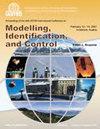小型无人机变展弦比机翼试验模态分析
IF 0.9
4区 计算机科学
Q4 AUTOMATION & CONTROL SYSTEMS
引用次数: 0
摘要
本文的主要目的是通过实验模态分析(EMA)获得佛罗里达理工学院设计和试飞的小型无人机(sUAV)的固有频率和模态振型。EMA是为了了解无人机的模态特性,作为了解飞机气动弹性特性的第一步。所研究的变展弦比(VAR)无人机采用可伸缩机翼,该机翼通过自适应改变展弦比可以在各种飞行状态下实现最优进化。使用ModalVIEW进行数据采集和分析。模态试验采用锤击激励和加速度计响应测量。该研究特别关注了两种不同的VAR机翼构型:完全缩回与完全展开机翼的模态特性差异。本文章由计算机程序翻译,如有差异,请以英文原文为准。
Experimental Modal Analysis of a Small Unmanned Aerial Vehicle with Variable Aspect Ratio Wing
The main purpose of this paper is to present the natural frequencies and mode shapes of a small unmanned aerial vehicle (sUAV), designed and test-flown at the Florida Institute of Technology obtained via experimental modal analysis (EMA). The EMA was performed in order to understand the UAV's modal characteristics as a first step aimed towards understanding the aeroelastic characteristics of the aircraft. The Variable Aspect Ratio (VAR) unmanned aerial vehicle (UAV) studied employs a telescoping wing which, by adaptively-changing its span can evolve optimally in all flight regimes. Data acquisition and analysis were performed with ModalVIEW. The modal tests employed hammer excitation and accelerometer response measurements. In particular, the study focused on the difference between modal characteristics of two different VAR wing configurations: fully retracted vs. fully extended wing.
求助全文
通过发布文献求助,成功后即可免费获取论文全文。
去求助
来源期刊

Modeling Identification and Control
工程技术-计算机:控制论
CiteScore
3.30
自引率
0.00%
发文量
6
审稿时长
>12 weeks
期刊介绍:
The aim of MIC is to present Nordic research activities in the field of modeling, identification and control to the international scientific community. Historically, the articles published in MIC presented the results of research carried out in Norway, or sponsored primarily by a Norwegian institution. Since 2009 the journal also accepts papers from the other Nordic countries.
 求助内容:
求助内容: 应助结果提醒方式:
应助结果提醒方式:


